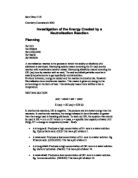For HCl bond :
- To break H = +436 KJ/mol
- To make H = -436 KJ/mol
Neutralisation:
Acid + Alkali Salt + Water
H+ (aq) + OH – (aq) H2O (l)
- No bonds need to be broken as the reactants are free in the solution
- 2OH bonds are made :
energy needed for O – H bond is – 464 KJ/mol
= (-464) 2
= - 928 KJ/mol
Neutralisation is an exothermic reaction; this means that it gives out energy in the form of heat. We can check this by measuring the temperature of the substance before and after the reaction.
For this experiment we will be using Hydrochloric acid (HCl) which has an acidic ph of about 1. this can be read using universal indicator and a chart. We will be using an alkali called Sodium hydroxide. (NaOH) This has a PH of 13. The equation of this reaction is :
HCl (aq) + NaOH (aq) NaCl (aq) + H2O (l)
Examples of Neutralisation in everyday life.
- Bee sting : This is acidic. It can be neutralised by bicarbonate of soda.
- Wasp sting : Unlike the bee sting this is alkaline and can be neutralised by vinegar.
- Indigestion : when there is too much acid build up in the stomach. It can be neutralised by an alkaline tablet.
Apparatus :
- 2 Burettes
- 2 Stand and clamp
- Funnel
- 2 Beakers
- Hydrochloric acid
- Sodium hydroxide
- Distilled water
- Universal indicator
- Materials and lids for insulation (lids with holes in to fit a thermometer.)
- Thermometer.
Variables :
We will carry out the experiment 6 times with different concentrations of the reactants which are hydrochloric acid and distilled water.
Safety:
- Safety goggles must be worn when using chemicals and at all times during the experiment.
- If any of the chemicals come in contact with skin or clothing it should be rinsed of immediately as they can be irritant or corrosive.
- Handle all glass with care as it may be hot after the reaction, and if any glass apparatus is smashed it should be cleaned up immediately and brought to the attention of all those around it.
- All bags and stools must be tucked under the desks as they can be tripped over in the working environment.
Method
- after collecting all the equipment I will then set it up. As shown in the diagram below. The burette will be help by the clamp while a beaker rests under the tap.
- I will then measure the desired amount (25mls) of sodium hydroxide into one of the beakers.
- I will then measure out the desired amount of hydrochloric acid and distilled water into the other beaker (these amounts will be varied through out the 6 experiments.)
- I will then pour the acid into the beaker that contains both the reactants, I will do this as quickly as possible so that I have time to place the lid on the beaker.
- I will then put the thermometer in the beaker and measure the temperature change until the temperature stops rising.
- I will then record the results on a table similar to the one below.
- I will then do the same on the other experiments however I will be changing the variables as required.
Prediction :
I predict that the more water and less acid is introduced into the solution will make it weaker and I think that this will slow down the reaction and it will cause less rise in heat.
Results Table :
Conclusion:
As less acid and more water is introduced to the sodium hydroxide the temperature decreases as does the difference in temperature.
When a solution is neutralised it takes part in an endothermic energy change, this means that the solution gives out heat if the reaction is more violent then there will be more heat produced.
The results as I predicted should go down in temperature as the hydrochloric acid is decreased and the water is increased.
Evaluation:
My results have been conclusive to scientific evidence and my prediction.
If I could re- do the experiment I would use better insulation and better measuring equipment.








